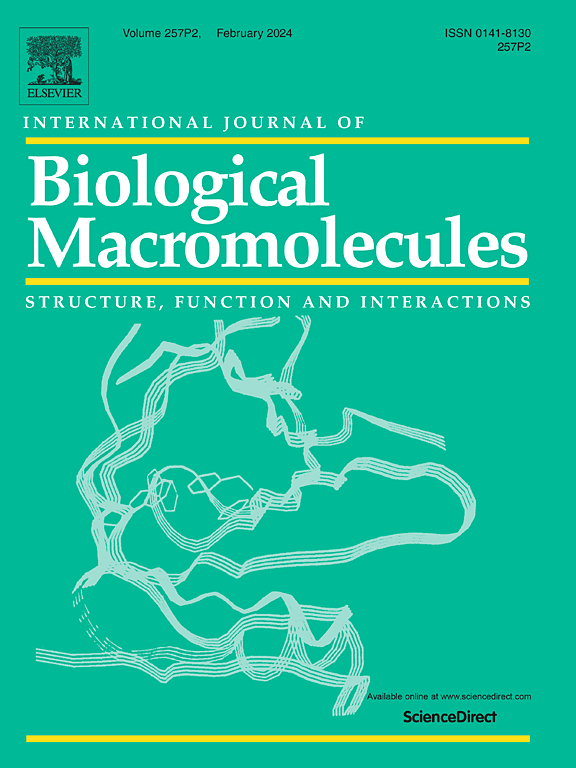从甘蔗甘蔗渣纸浆制备电活性材料:羧甲基纤维素/还原氧化石墨烯/氧化镍复合材料作为高性能超级电容器组件。
IF 8.5
1区 化学
Q1 BIOCHEMISTRY & MOLECULAR BIOLOGY
International Journal of Biological Macromolecules
Pub Date : 2025-06-01
DOI:10.1016/j.ijbiomac.2025.144703
引用次数: 0
摘要
我们报道了从蔗渣纤维素中提取的生物源导电材料。首先,将纤维素化学转化为羧甲基纤维素(CMC)。将丙烯酰胺(AM)和2-丙烯酰胺-2-甲基-1-丙磺酸(AMPS)与CMC共聚合,并与N,N ' -亚甲基双丙烯酰胺(MBA)交联,以改善其力学性能。为了进一步提高材料的电性能,我们用还原氧化石墨烯(rGO)、氧化镍(NiO)纳米颗粒和rGO@NiO复合材料对材料进行了改性。然后,纳米复合材料被用作固态超级电容器的电极。采用循环伏安法(CV)、恒流充放电法(GCD)和电化学阻抗谱法(EIS)评价材料的电化学性能。这些结果表明,氧化石墨烯和NiO NPs改性的复合材料的电化学性能得到了提高。CV曲线表现出明确的氧化还原峰,表明可逆法拉第过程,证实了高赝电容贡献。优化后的样品XGNi2.5在0.5 a g-1时具有497.8 F g-1的高比电容,在5000次 循环后具有优异的循环稳定性,电容保持率为91 %,在功率密度为226.2 W kg-1时具有44.2 Wh kg-1的最大能量密度。EIS显示出低的电荷转移电阻和高效的离子输运。这些结果强调了CMC/rGO/NiO复合材料作为下一代超级电容器可持续的高性能电极材料的潜力。本文章由计算机程序翻译,如有差异,请以英文原文为准。
From sugarcane bagasse pulp into electroactive materials: Carboxymethyl cellulose/reduced graphene oxide/nickel oxide composites as high-performance supercapacitor components
We report bio-sourced electrically conductive materials derived from sugarcane bagasse cellulose. First, the cellulose was chemically transformed into carboxymethyl cellulose (CMC). Acrylamide (AM) and 2-acrylamido-2-methyl-1-propanesulfonic acid (AMPS) were co-polymerized with CMC, and the resulting material was cross-linked with N,N`-methylenebisacrylamide (MBA) to improve its mechanical properties. To further enhance the electrical performance, the materials were modified with reduced graphene oxide (rGO), nickel oxide (NiO) nanoparticles and rGO@NiO composites. The nanocomposites were then used as electrodes for solid-state supercapacitors. To evaluate the electrochemical properties of these materials, cyclic voltammetry (CV), galvanostatic charge-discharge (GCD), and electrochemical impedance spectroscopy (EIS) were performed. These results demonstrate enhanced electrochemical performance of the composite material modified with both rGO and NiO NPs. CV profiles exhibited well-defined redox peaks indicative of reversible faradaic processes, confirming high pseudocapacitance contributions. The optimized sample XGNi2.5 exhibited a high specific capacitance of 497.8 F g−1 at 0.5 A g−1, outstanding cycling stability with 91 % capacitance retention after 5000 cycles, and a maximum energy density of 44.2 Wh kg−1 at a power density of 226.2 W kg−1. EIS revealed low charge transfer resistance and efficient ion transport. These results underscore the potential of CMC/rGO/NiO composites as sustainable, high-performance electrode materials for next-generation supercapacitors.
求助全文
通过发布文献求助,成功后即可免费获取论文全文。
去求助
来源期刊
CiteScore
13.70
自引率
9.80%
发文量
2728
审稿时长
64 days
期刊介绍:
The International Journal of Biological Macromolecules is a well-established international journal dedicated to research on the chemical and biological aspects of natural macromolecules. Focusing on proteins, macromolecular carbohydrates, glycoproteins, proteoglycans, lignins, biological poly-acids, and nucleic acids, the journal presents the latest findings in molecular structure, properties, biological activities, interactions, modifications, and functional properties. Papers must offer new and novel insights, encompassing related model systems, structural conformational studies, theoretical developments, and analytical techniques. Each paper is required to primarily focus on at least one named biological macromolecule, reflected in the title, abstract, and text.

 求助内容:
求助内容: 应助结果提醒方式:
应助结果提醒方式:


